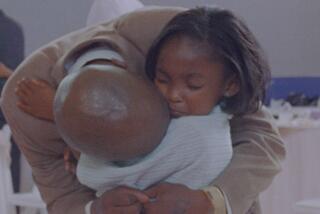Center for Delinquents Tries to Give Parents Power
- Share via
Many experts who work with problem children agree that sending them to juvenile detention facilities does little to change their delinquent behavior.
But that doesn’t mean they don’t believe in punishment.
“Punishment generally means going to jail,” said Eugene Patterson, research director of the Oregon Social Learning Center in Eugene, Ore. “Those things don’t work. They don’t change the behavior in a way that reduces the likelihood of the child doing it again.
“The studies we and others have done indicate that if a parent punishes a child by giving him a work detail to do, it does reduce the likelihood he’ll do it again--even if he’s a serious, chronic delinquent.”
At the center, Patterson and others have used this method to improve the behavior of antisocial, delinquent children.
Patterson believes that many of them get that way because their parents don’t know how to run their family. Rather than teaching their children to obey basic rules, these parents encourage their children to coerce and disobey, by backing down in response to whining, yelling or temper tantrums.
As the child becomes more coercive, he becomes harder to discipline. The parents are apt to explode and physically assault the child. About one-third of the antisocial boys referred to the Oregon clinic for treatment have been found to be physically abused, Patterson said.
“The noncompliant and coercive features of the child’s behavior places him or her directly at risk for both rejection by normal peers and academic failure,” Patterson said. “The same pattern of behavior in the home leads to parental rejection and, in turn, to the child’s development of low self-esteem. Academic failure, rejection by peers, and possibly low self-esteem are thought to place the child at greater risk for remaining in the process.”
At the center, parents and children undergo intensive therapy for the purpose of “putting the parents in charge of the family and teaching them how to negotiate with their children,” Patterson said.
Here’s how it works:
First, the entire family comes to the clinic, where a therapist helps them examine why the parents have been unable to consistently discipline the child in the past. At the same time, they draw up a list of chores the child will be assigned when he refuses to do as he is told.
“We decide these things in advance, and the child is in on the planning,” Patterson said. “We also train these families to have a list of backup contingencies; you can pretty well bet the child will do some of the things he’s done in the past.”
After some role-playing and rehearsing in the clinic, the family tries out the new system at home.
In adolescents, parents impose a work detail for such offenses as, say, swearing at their mothers. If the chore isn’t done, the parents follow up with strict imposition of further punishment--like withholding use of the car for a week.
A young child who balks or talks back to his parents may be sent to his room for five minutes. The next step might be locking up the TV set.
“The next time he’s swearing at his mother, and he’s given a work detail, perhaps he’ll stop and think just a second. Maybe he will lose the car two or three times this way, but eventually, he’ll start to catch on.”
Initially, Patterson said, most children don’t believe their parents will go through with the prescribed punishment, since they have often failed to do so in the past. A period of testing is common.
During that time, he said, the parents are encouraged to help each other. “There are a lot of very depressed people in these situations. Some are alcoholics. Some have marital conflicts. We try to get the family back together and teach them to manage their children. It’s very intensive.”
It’s also time-consuming, he said. “It takes an average of 18 hours of professional time.”
Since 1960, the Oregon Social Learning Center has treated between 200 and 300 families using this form of therapy, Patterson said. The three follow-up studies that have been done have shown that three out of four preadolescents are back within normal behavior ranges after the treatment.
Twelve months later, they are still behaving normally. Parents also report that their children are getting along better with other children and are doing better in school, Patterson said.
More to Read
Sign up for Essential California
The most important California stories and recommendations in your inbox every morning.
You may occasionally receive promotional content from the Los Angeles Times.












